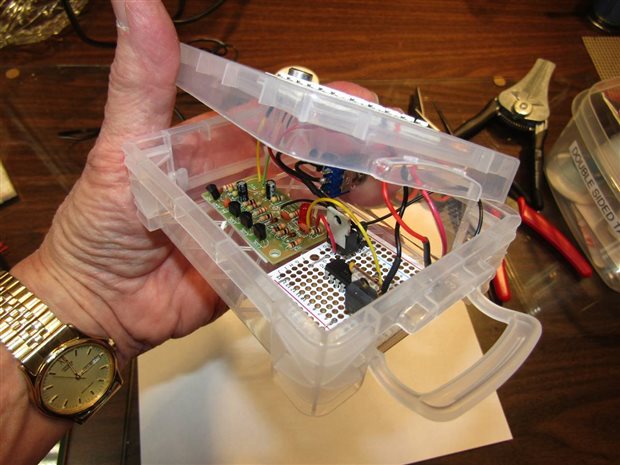Thanks to Christmas Vacation I had the opportunity to spend the day doing electronics with my 11 year old Grandson Ivan. We began with a small Chinese noise actuated clap switch.
As you can see the kit comes with no directions other than the silk screening on the board. I had explored this kit a while back and reverse engineered a schematic so Ivan had that as a guide as well.
It is a simple 2 stage audio amplifier that triggers a transistor flip flop which in turn lights a small LED. It is designed to operate at 5 volts. Ivan has become very adept at building these Chinese kits and he is also knowledgeable about my shop. With few exceptions I just turn him loose and let him work. Today at one point he got too much solder on the board so that two pads were bridged. I did not realize this until I saw that he had retrieved the solder wick from the drawer and was making the proper remedy to the problem. As he worked we discussed how we could take this simple, not so practical, circuit and make something useful out of it. The idea came up that he would like a light by his bed so that when he got up at night he could just clap and have light. I began to check for resources in the shop and found a small 2 watt 12 volt LED panel, a 12 volt linear wall wart, a project box of the right size, a nice prototyping board, and a power switch. Since we would be building the kit to integrate with the rest of the components I told Ivan to leave the microphone and power jack off the board. We would mount them to the project box when we assembled the whole unit.
I made a simple drawing of the support circuitry we would need to run the 12 volt LED panel and the 5 volt kit. Due to the design of the kit it would also be necessary to invert the output of the kit so that we would sync the LED panel with the small red LED on the kit board that was being driven directly from the flip flop. Since my hand drawing doesn't scan very well I have made a quick schematic.
As Ivan continued to work on the kit, he was decoding the color codes of the resistor at this point, I started to bread board the support circuit just to make sure it would work and also to give Ivan the layout so he could directly transfer it onto the prototype board. I love the Adafruit prototyping boards that have the same layout as a bread board and this makes simple work of transferring a layout.
Here was the bread board layout which seemed to work using the sample Clap Switch circuit I had built a couple weeks earlier.
After Ivan finished with the kit board he began to work on the support board. I helped by placing components and he soldered them in place. Since we were approaching 4 hours interrupted only by lunch I asked him if he was getting tired of electronics and he said no. I want this to be fun for him and not a job so I try to be conscious of his interest level. He stays so focused and interested I frankly forget that he is only eleven. I apologize that I did not get better pictures of the final assembly. Due to the difficulty of holding wires in place I would be the one to hold them and he continued to solder them. Here is a picture of the boards in the completed project box as well as a picture of the unit finished.
We had mounted the LED array and the Microphone on top of the box and the main switch was on the back where the wire from the 12 volt wall wart entered.
Here is a short video of Ivan demonstrating the Clap Switch Light for you.
The actual bench time for building this small project today was over 5 hours. Ivan's focus and enthusiasm made every minute a joy.
Happy Grandpa
John








Top Comments
-

jc2048
-
Cancel
-
Vote Up
+2
Vote Down
-
-
Sign in to reply
-
More
-
Cancel
-

jw0752
in reply to jc2048
-
Cancel
-
Vote Up
+4
Vote Down
-
-
Sign in to reply
-
More
-
Cancel
-

mcb1
in reply to jw0752
-
Cancel
-
Vote Up
+1
Vote Down
-
-
Sign in to reply
-
More
-
Cancel
-

Jan Cumps
in reply to jw0752
-
Cancel
-
Vote Up
+2
Vote Down
-
-
Sign in to reply
-
More
-
Cancel
-

jw0752
in reply to mcb1
-
Cancel
-
Vote Up
+1
Vote Down
-
-
Sign in to reply
-
More
-
Cancel
-

jw0752
in reply to Jan Cumps
-
Cancel
-
Vote Up
+2
Vote Down
-
-
Sign in to reply
-
More
-
Cancel
-

jc2048
in reply to jw0752
-
Cancel
-
Vote Up
+2
Vote Down
-
-
Sign in to reply
-
More
-
Cancel
Comment-

jc2048
in reply to jw0752
-
Cancel
-
Vote Up
+2
Vote Down
-
-
Sign in to reply
-
More
-
Cancel
Children